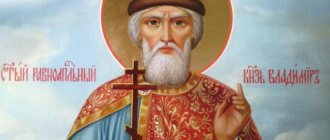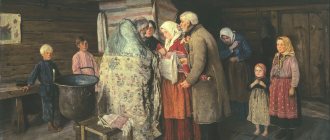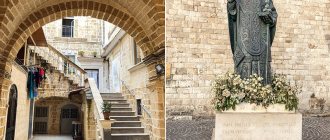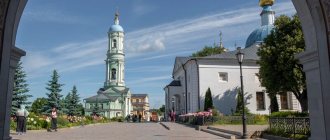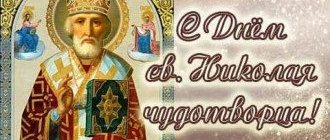Nicholas the Wonderworker is one of the most revered saints in Orthodoxy and the Christian world. In Catholic countries, Nicholas the Wonderworker became the prototype of Father Frost (Santa Claus, Saint Nicholas). In the Orthodox world, not only believers know or have at least heard about St. Nicholas the Pleasant, but also those who have never been to church.
Why was the life of St. Nicholas the Wonderworker so remarkable? When did Saint Nicholas live? What miracles happened under him? How does St. Nicholas the Wonderworker help?
What is St. Nicholas the Wonderworker famous for?
Saint Nicholas is one of the most revered saints. Moreover, not only in Orthodoxy, but also in other Christian denominations (Catholic, Protestant, Armenian, etc.), since he lived before all the schisms, and the Church was still united then.
The fact that St. Nicholas is so famous does not mean that he is better than other saints - comparisons are generally inappropriate here. But his fame largely developed historically: after all, he performed his miracles and exploits while not a monk in some monastery, but as the ruling bishop in the most developed country at that time.
Saint Nicholas is the personification of several exploits and ministries at once:
- He was a miracle worker who healed people and saved them from death.
- He was a theologian who had a keen sense of doctrinal issues and defended the truth in disputes with heretics - who at that time had a very strong influence in the Empire.
- Saint Nicholas was not just a metropolitan (that is, a priest-bishop who heads an entire metropolitanate), but first of all a loving shepherd and a selfless protector for his people.
- And finally, Saint Nicholas no less personifies the feat of humility and obedience - since he never sought the rank of metropolitan and also publicity. And in general, in his youth, like any monk, he probably dreamed of solitude and desert. However, having become a metropolitan, he seemed to “forget” about his desires and devoted himself entirely to the service that the Lord had prepared for him.
Icon of St. Nicholas the Wonderworker depicting various moments from his life
Brief Life
The future saint was born in the second half of the 3rd century in the Lycian region, located on the southern coast of the Asia Minor Peninsula, in the city of Pahar. He was the only child of pious parents Nonna and Feofan, who vowed to dedicate him to God. Until they were very old, they prayed to the Lord to give them a son, and their fervent prayer was heard. The Lord gave them a newborn, who at holy baptism was named Nicholas, which means in Greek “victorious people.” And he lived up to his name, becoming the conqueror of evil, for the benefit of all humanity.
Miracles in Infancy
From the first days of his life, the future saint showed people that he was in a special place with God. Immediately after giving birth, his mother Nonna was healed of her illness and became infertile again. During the baptism, the baby himself stood alone in the font for more than three hours, which was regarded by people as a great Miracle.
And subsequently Saint Nicholas led a strict ascetic life, remaining faithful to God until his death. From the first days of his life, the baby began to adhere to a fasting life. On all days of the week he regularly fed on his mother's milk. However, on fasting days of the week according to the church calendar (Wednesday and Friday), he was applied to the mother’s breast only once - after the parents read the evening prayers.
Miracles in adolescence
As a child, Nikolai, guided by the Holy Spirit, a strong and sharp Mind, as well as diligence, diligently comprehended book wisdom. First of all, I studied the Divine Scripture. His love for the temple of God was expressed in his desire to stay there for many days in a row, constantly praying to God and reading divine books.
Over time, having achieved perfection in words and studies, he showed his merits in everyday life. He avoided fuss, idle conversations, and communication with women. Until the end of his life, Saint Nicholas retained chastity, a pure mind, and devotion to the Lord. He received the greatest joys in life from visits to the temple of God, about which the Psalmist David said in Psalm 83: “I would rather be at the threshold of the house of God.”
His uncle, Bishop Nicholas of Patara, paying attention to the spiritual zeal and high piety of his nephew, introduced him to the sacrament of the Priesthood. First he made him a reader, and then ordained Nicholas to the priesthood, making him his assistant. The main task of the young priest was to deliver teachings to the flock. In this field, the young man showed himself to be such an experienced mentor in matters of faith that he was compared to the elder.
Such learning aroused surprise and deep respect among believers. Being in labor, vigilance and unceasing prayer, Presbyter Nicholas demonstrated great mercy to those around him: he always came to the aid of those in need, and distributed all his property to the poor after the death of his parents. When giving alms, he always did it secretly, hiding his good deeds from everyone.
Through secret assistance, he helped one once rich man with a dowry for his three daughters. The unfortunate father, out of need, decided to sacrifice the honor of the girls in order to obtain funds for their marriage. But Saint Nicholas, having learned through God’s providence about his father’s criminal plans, did not allow that man to push his daughters onto the criminal path of fornication. At night, he secretly planted three bags of gold, and the honor of the three beautiful sisters was saved. Their father gave them all a decent dowry and successfully married them off.
Miracles during the pilgrimage to Jerusalem
Miracles also happened during a pilgrimage trip to Jerusalem, when the ship encountered a strong storm on the way. Through the fervent prayer of the saint of God, the sea became calm. And the sailor, who died falling from a high mast onto the deck, was resurrected to life. With tears, Saint Nicholas gave glory to Jesus Christ at the place of his execution - Golgotha. After all, with his death the God-man atoned for our sins.
With reverence he bowed to all the shrines in Jerusalem. The doors of the church on Mount Zion themselves opened before St. Nicholas. He decided to retire to the desert in order to devote himself entirely to serving God. But the Lord decided differently. In a dream, he showed Nikolai his will - to return to his homeland to continue the feat of service there. On the return voyage, the ship's crew planned to take Saint Nicholas to other countries, but the Lord ruined their plans. Through the prayer of the saint, a strong tail wind arose, which drove the ship in the direction of Lycia.
Election as Archbishop of Lycia
Having set foot on his native land, the saint of God again began to tempt fate. He decided to become a monk in order to end his earthly life in obscurity. For this, he asceticised in the monastery of Holy Zion. But the Lord appeared to him a second time and again indicated that he expected from him not feats of silence, but glorification of God’s name in serving people.
Obeying providence from above, the lamp of faith nevertheless decided not to tempt itself with human glory. Therefore, he went not to his native Patara, but to the capital of Lycia, the city of Myra. Nobody knew him there. Here he began to eke out a miserable existence, but was always present at all church services. The humility of Saint Nicholas pleased God, and he decided to exalt him. The opportunity soon presented itself. Archbishop John died, and the bishops of Lycia gathered to elect a new shepherd.
But there was no unanimity. Therefore, they stood up for joint prayer so that the Lord would help in choosing His chosen one. The prayer was heard: the eldest bishop had a vision of a man in light clothes. He ordered him to spend the night in the vestibule of the temple. Ask the first visitor his name, and if he calls himself Nicholas, elect him archbishop. By the will of God, the first to enter the temple was a beggar, who humbly announced his name. So Saint Nicholas became the ruling bishop of the Lycian Church.
Test by dignity
Icon of St. Nicholas the Wonderworker in the Tulgan Church
Being an archbishop, God's Pleasant remained just as humble, meek and merciful. His clothes were simple, he worked during the day, and only sat down to the Lenten meal in the evening. For all people, regardless of their wealth, age, or state of health, St. Nicholas was the center of blessings.
Giving alms, helping with advice and instructions, most of all he strove to cleanse the souls of his flock from sinful abscesses. When the persecution of Christians began during the time of Emperor Diocletian, Archbishop Nicholas, along with other believers, was placed in prison. There he did not complain, steadfastly endured the pangs of hunger and thirst, and was an example for others in the true Faith.
His courage served as an example for desperate prisoners. The saint was ready to accept martyrdom, but the Lord gave him life for the benefit of the Church. When Emperor Constantine took the throne, the persecution of Christians stopped, the prisoners were released, and the Church was given freedom and peace.
Slap Aria
St. Nicholas the Wonderworker returned to Mira and continued to enlighten his flock. He devoted a lot of time and effort to converting pagans to Christianity, fighting against their worship of idols and temples. In those days, the heresy of the false teaching of Arius began to spread, denying the consubstantiality of the Beginningless God the Father with His Son, the Lord Jesus Christ.
To put an end to Arianism in Nicaea in 325, Emperor Constantine convened the First Ecumenical Council. More than 300 archbishops gathered for it, including St. Nikolai. There he entered into a discussion with Arius, during which he slapped the heretic.
The participants of the Council punished him for this: they removed him from the rank of bishop and put him in prison. At night, some delegates had a vision: Jesus Christ blessed His Saint with the Holy Gospel, and the Blessed Virgin Mary covered him with an omophorion. These signs were interpreted as encouraging the audacity of St. Nicholas. He was honored and restored to the rank of bishop.
Nikolai Ugodnik - why is he called that?
St. Nicholas the Wonderworker is often popularly called St. Nicholas the Pleasant - that is, a saint who pleased God. Although, in fairness, any saint, not just Nicholas, pleased God in his life - because the very essence of holiness is servility.
Holiness is not just good deeds and deeds - they do not make you a saint. Holiness is the acquisition of such Grace as can only be accepted by people who are pure in heart. And keeping your heart pure is the best way to please God.
Saints are given the Grace of the Holy Spirit, and it helps them to accomplish feats that they, the saints, would never have accomplished on their own without God’s Help. And only with God’s Help was it possible to live the intense life that St. Nicholas lived—who, like every saint, pleased God.
An image that turns away from sin
An example of this is the image known as “Nikola the Disgusting.” It is characterized by the fact that on it the face of the holy wonderworker, which occupies almost the entire board, is given particularly stern features, and his eyes are averted to the side, as if refusing to look at the iniquities committed by people. Researchers believe that this type of icon of St. Nicholas the Wonderworker among the Kerzhaks - members of Old Believer communities who settled, starting in the 18th century, in the Nizhny Novgorod province along the banks of the Kerzhenets River. They were particularly ardent adherents of “ancient piety,” and the image of St. Nicholas the Wonderworker, born in their workshops, was, first of all, supposed to turn people away from the sin that filled the world after the Nikon reform, which was, in their opinion, ungodly.
Miracles of St. Nicholas
Saint Nicholas helps sailors in distress
Tradition has preserved the memory of the many miracles of St. Nicholas and many examples of his help to the simplest people.
- At Christmas, he secretly brought gifts to children from poor families and placed them under the door. This is how Santa Claus “appeared” - our Father Frost.
- One day, Saint Nicholas helped a man who was so poor that he was ready to give his daughters into slavery. The saint saved the girls from dishonor by secretly throwing a bag of gold into the house - and thereby providing each daughter in turn with a good dowry for marriage.
- Nicholas the Wonderworker helped the residents of the metropolis several times during drought and famine. For example, he once appeared in a vision to a merchant who was sailing past on a ship with grain. After the vision, the merchant mysteriously had the money in his hands, which the saint “gave” for bread. For the merchant it was a profitable deal and he left all the grain to the residents.
- And one day Saint Nicholas saved his people from a high tax. He personally went to the then Emperor Constantine and explained that the amount of the quitrent was assigned unfairly - and solely because of the greed of “local officials.” Emperor Constantine appreciated the saint’s intercession (in addition to the fact that he generally respected him before) and the tax was eventually reduced.
- More than once Saint Nicholas stood up for citizens in cases of unfair court decisions - and this helped to cancel the execution of innocent people.
- More than once, Nicholas the Wonderworker saved sailors during storms.
- And so on, and so on, and so on...
In general, Saint Nicholas personified a true shepherd. And the people preserved his memory in gratitude. Yes, such a thing that probably few ascetics in the entire Orthodox Church have received.
Saint Nicholas saves those unjustly convicted from death
The most famous miracles.
Every year on September 1, Saint Nicholas gathered the clergy to a Council, consulted about the needs of the people, ordering them to take care of the poor. The bishop himself lived very modestly, worked zealously to save his flock, and lovingly helped in times of trouble and sorrow.
Thus, when the mayor of the city of Myra took a bribe and sentenced three innocent young soldiers to death, the saint appeared and saved them. At the time when the executioner wanted to execute, Saint Nicholas appeared and delayed the execution of the sentence. Then he spoke so convincingly with the mayor that he not only admitted to dishonesty, but also apologized.
In his most famous exploit, first attested in Archimandrite Michael's Life of St. Nicholas, Nicholas heard of a devout Patara man who was once rich but lost all his money due to "the conspiracy and envy of Satan." The man could not afford a decent dowry for his three daughters. This meant that they would remain unmarried and likely, in the absence of other possible work, would be forced to become prostitutes.
Upon learning of the girls' plight, Nicholas decided to help them, but, being too modest to help the family publicly (or to spare them the humiliation of accepting alms), he went into the house under cover of darkness and threw a wallet filled with gold coins through the window opening into house. According to another interpretation of this legend, he threw money into the chimney, and that evening the sisters hung washed stockings by the fireplace to dry. The coins thrown by Nikolai ended up in them (this is where the tradition of hanging beautiful socks for gifts by the fireplace or stove in our time came from).
The father immediately arranged the wedding of his first daughter, and after her wedding, Nikolai threw a second bag of gold through the same window late at night. According to Archimandrite Michael's account, after the second daughter was married, the father stayed awake for at least two "nights" and caught Saint Nicholas in the act of the same act of mercy towards the third daughter. The father fell to his knees, thanking him, and Nikolai ordered him not to tell anyone about the gifts.
The scene of Nicholas's secret gift-giving is one of the most popular scenes in Christian religious art, appearing in icons and frescoes from all over Europe. Although depictions vary depending on time and place, Nicholas is often shown wearing a hood, while the daughters are usually shown in bed, wearing nightwear. Many images contain a cypress tree or a cruciform dome. Also often on icons, Saint Nicholas is depicted with three bags of gold.
And now on St. Nicholas Day, gifts are traditionally placed in beautiful socks, which are hung near the fireplace or stove.
Here is a case of saving the hungry. When the famine began in the city of Mir, Saint Nicholas prayed and zealously asked God for help. It was at this time in Sicily that Saint Nicholas appeared to a bread merchant in a dream, who gave him a good cash deposit and ordered a ship of bread for the hungry in Myra. Waking up, the merchant, to his surprise, found money in his fist and was finally convinced that this was not an ordinary dream, but a revelation from God. The merchant immediately filled the ship with bread and sailed to Myra, where Saint Nicholas bought this bread from him for the hungry.
Another story says that Nicholas visited the Holy Land. The ship he was on was almost destroyed by a terrible storm, but the Lord heard the Saint’s prayer, and the storm calmed down. So Saint Nicholas saved the fishermen with his prayer during this storm. Thanks to this miracle, Nicholas became the revered patron of sailors and travelers. Therefore, even today, sailors and fishermen, all travelers ask St. Nicholas for the protection of God, and in many countries churches have been built on the seashore in his honor.
Another famous legend tells how he resurrected three children who had been killed and pickled in brine by a butcher who planned to sell them as pork during a famine. Therefore, Saint Nicholas is often depicted on icons with children in a basket.
Nicholas could heal the crippled, the sick, and repeatedly saved those sentenced to death. But his greatest merit was that he loved all people immensely and valued each individual person. His life is one of love and service to people.
Merciful, honest, truth-loving, he walked among people like an Angel of God. Even during his life, people revered him as a saint, calling for help in troubles and sorrows; and he appeared - in dreams and in reality - calling him, easily and quickly covering any distances, protecting and strengthening them. His face shone with light, like the face of Moses, so that by his very appearance he brought people consolation, peace and complacency.
According to Saint Andrew of Crete, Saint Nicholas appeared to people burdened with various disasters, gave them help and saved them from death: “With his deeds and virtuous life, Saint Nicholas shone in the World, like a morning star among the clouds, like a beautiful moon in its full moon. For the Church of Christ he was a brightly shining sun, he adorned Her like a lily at a spring, and was for Her a fragrant world!”
Nicholas the Wonderworker - Defender of Orthodoxy
The end of the 3rd and beginning of the 4th centuries, when Saint Nicholas lived, was also a time when Christianity went through the difficult path of formulating doctrinal truths.
What does it mean?
All spiritual definitions (and the Creed at their core) and all the dogmas by which the Church now lives were formulated precisely then. It was necessary to do this, since Christianity was covering ever larger territories. The Christian communities and peoples who were baptized became increasingly fragmented and diverse. Increasingly, teachings began to arise that distorted one or another Christian truth.
These heresies arose not due to any evil intent, but precisely due to the lack of formulated dogmas. For example, some bishop taught his flock the way he himself felt the Christian faith. Somewhere he could be mistaken and thus broadcast his delusions to entire cities: he had students and followers who, in turn, taught people, etc. At times, heretical teachings could cover territories no smaller than Orthodoxy.
Nicholas the Wonderworker was one of the most ardent defenders of Orthodox truths. Sometimes he could be overly emotional - at one of the Ecumenical Councils, where the dogmas were being formulated, he even slapped his opponent - for which he was immediately expelled for disciplinary purposes.
Nevertheless, for all his integrity, Saint Nicholas was not reckless. For example, when Christianity was not yet an official religion in the Roman Empire, Saint Nicholas did not destroy pagan temples - as he began to do later. Because he understood that by doing this, he would bring wrath not only on himself, but also on his entire flock.
History of the Feast of St. Nicholas
Nicholas was the son of wealthy parents; from childhood he dreamed of devoting his life to serving God, and as a young man, during the Diocletian persecution, he became a priest. After the death of his parents, he distributed a large inheritance to the poor. Bishop Nicholas was a good shepherd, a protector of the innocently condemned and persecuted, a benefactor and a secret donor. He was revered for his mercy, and faith in his help was strengthened over the centuries. In 1087, when the city of Myra was already under Muslim rule, residents of the Italian city of Bari secretly took the relics of the saint to themselves.
Russian Orthodox statue of Saint Nicholas, currently located next to the church in Demre. Photo: Commons.wikimedia.org
Nikolai Ugodnik, what does he help with?
Saint Nicholas is one of the most revered saints in our country. People turn to him with prayer and requests for help more often than many other saints.
How does St. Nicholas the Wonderworker help? This is an issue in which there has been a lot of speculation. It is believed, for example, that Nikolai Ugodnik helps with work: the unemployed can find it as quickly as possible, and those who have a job can cope with it better. Wikipedia writes that Nicholas the Wonderworker is the patron saint of sailors and travelers.
However, to see a saint as an intercessor in only one thing is rather a superstition that has nothing to do with the depth of Church life.
Any saint helps in everything. Any saint is glad to be an intercessor before God for everyone who turns to him. Therefore, Nikolai Ugodnik can help not only with work, but also with studies, or with health problems, or with difficulties in family life.
Nicholas the Wonderworker is our intercessor before God. And his intercession - like the intercession of any saints for any of us - is one of the most wonderful aspects of Church life. And a wonderful testimony that in Christ people are united not only at a distance, but also over time!
Features of the life-size image of the saint
As another option for writing the icon of St. Nicholas the Wonderworker, we can mention his life-size image, in which the Miracle Worker of Myra is presented in full height, which is clear from his very name. The vestment on it is the same as on the belt icons, but in this case tradition allows for different positions of the hands. Most often, traditionally, the saint blesses the viewer with his right hand, and holds the Gospel in his left. However, often both of his hands are depicted raised upward, which corresponds to the prayerful pose of the Most Holy Theotokos in Her iconographic versions such as “Oranta” (Praying).
Miraculous birth
Lives (books that describe the lives of saints after canonization) tell that Nicholas was born into a family of deeply religious Feofan and Nonna, who had no children for a long time. After fervent prayers and a vow to dedicate the child to God, Nikolai was born. Literally from birth, he already began to show his wonderful talents to those around him.
At his baptism, the newborn stood in the font for about three hours without any support. It must be said that the sickly Nonna was healed after the birth of her pet - the birth of her baby, who later became a great revered saint, had such a beneficial effect on the mother’s health.
The wanderings of the holy relics of Nicholas the Ugodnik
A truly detective story happened with the relics of Saint Nicholas in the Middle Ages. In the 11th century, the Turks devastated the Byzantine lands in Asia Minor, simultaneously erasing every trace of Christianity in those lands: they plundered churches, burned books, and destroyed icons. An equally sad fate awaited the relics of St. Nicholas.
The Christians of Italy, among whom there were many Greeks, were especially worried about the shrine. In April 1087, an expedition set out from the city of Bari to collect the relics of the saint and transport them to Italy. 47 people came to the church where the shrine was kept and began to ask about the relics of the four monks guarding the temple. In their simplicity, they not only showed them where the relics were kept, but also told them that Saint Nicholas had recently appeared in a dream to an elder and asked him to better guard his remains.
The saint pointed to the possibility of abduction, but the Barians interpreted the vision completely differently: they considered it a direct indication of the saint to transfer the relics from the land desecrated by the Turks. The Italians decided not to hide their plans and announced to the monks their intention to take the relics, offering 300 gold coins in compensation. The guardians of the shrine refused with contempt, but strength was not on their side, and the Barians, having taken the bulk of the relics, transferred them to the ship. The guardian monks gathered people on the pier, but it was too late: the ship with the relics sailed to Italy. In Bari, the newly found shrine was solemnly placed in the Church of St. Stephen, where several miraculous healings of believers from ailments immediately took place. A year later, a church was built in the name of St. Nicholas, and Pope Urban II came to consecrate it.
During the First Crusade, the fragments of the saint's relics remaining in Lycia were taken by Venetian sailors, who revered Nicholas the Wonderworker as their patron. The authenticity of the saint's relics was subsequently proven by scientific research: it was established that fragments of skeletons in Bari and Venice belong to the same person.
In 2009, scientists at the University of Manchester reconstructed the appearance of St. Nicholas from the remains: according to the study, he was a man of strong build, approximately 1 meter 68 centimeters tall, dark, brown-eyed, with prominent cheekbones and chin.
Legends about the icons of St. Nicholas the Pleasant
A great many icons depicting St. Nicholas the Wonderworker were painted in Rus'. Some of them are considered miraculous; amazing stories have happened to them. Here are just two of them.
They say that in the 17th century, an icon of St. Nicholas was found on a stump in one of the forests of the Chernigov province. Three times she was carried to the nearest church, but each time she miraculously found herself in the same place. Then a wooden church was erected right above the stump, which, of course, was called Nikolskaya.
In 1794, a stone building was erected in its place. It was not for nothing that the magical icon in it was reputed to be miraculous. Many people prayed in front of her. Among them was Maria Ivanovna Gogol. Her two newborn children died in infancy, and she asked the saint to intercede for the life of her child, who was about to be born. When Maria Ivanovna was safely delivered of her pregnancy, she named her son Nikolai.
He became a famous Russian writer. In his first book, “Evenings on a Farm Near Dikanka,” Nikolai Vasilyevich narrates the story on behalf of the sexton of the St. Nicholas Church - the very one in which his mother once prayed.
Celebration traditions
In Russia, St. Nicholas Day was celebrated by sharing, with pies, beer or mash made from the grain of the new harvest. It was a holiday for the elders in the family and clan. “Call a friend to Nikolshchina, call a foe - both will be friends.”
On Nikola, winter is finally taking hold. People say: “Praise winter after St. Nicholas Day.” “If Nikolina’s day came, it would be winter.”
Previously, in Ukraine, it was from this day that young people began to prepare for Christmastide, matchmaking and vespers: they wove dowries, sewed outfits and made masks for Yuletide entertainment.
St. Nicolas day. Painting by Dutch artist Jan Steen, c.1665-1668. Photo: Commons.wikimedia.org

